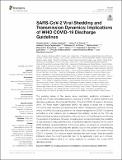Files in this item
SARS-CoV-2 viral shedding and transmission dynamics : implications of WHO COVID-19 discharge guidelines
Item metadata
| dc.contributor.author | Badu, Kingsley | |
| dc.contributor.author | Oyebola, Kolapo | |
| dc.contributor.author | Zahouli, Julien Z.B. | |
| dc.contributor.author | Fagbamigbe, Adeniyi F. | |
| dc.contributor.author | de Souza, Dziedzom K. | |
| dc.contributor.author | Dukhi, Natisha | |
| dc.contributor.author | Amankwaa, Ebenezer F. | |
| dc.contributor.author | Tolba, Mai F. | |
| dc.contributor.author | Sylverken, Augustina A. | |
| dc.contributor.author | Mosi, Lydia | |
| dc.contributor.author | Mante, Priscilla Kolibea | |
| dc.contributor.author | Matoke-Muhia, Damaris | |
| dc.contributor.author | Goonoo, Nowsheen | |
| dc.date.accessioned | 2021-07-16T14:30:10Z | |
| dc.date.available | 2021-07-16T14:30:10Z | |
| dc.date.issued | 2021-06-17 | |
| dc.identifier | 275078899 | |
| dc.identifier | 993539d9-f194-4032-ae5e-42dd84c3ef2b | |
| dc.identifier | 000669990800001 | |
| dc.identifier.citation | Badu , K , Oyebola , K , Zahouli , J Z B , Fagbamigbe , A F , de Souza , D K , Dukhi , N , Amankwaa , E F , Tolba , M F , Sylverken , A A , Mosi , L , Mante , P K , Matoke-Muhia , D & Goonoo , N 2021 , ' SARS-CoV-2 viral shedding and transmission dynamics : implications of WHO COVID-19 discharge guidelines ' , Frontiers in Medicine , vol. 8 , 648660 . https://doi.org/10.3389/fmed.2021.648660 | en |
| dc.identifier.issn | 2296-858X | |
| dc.identifier.other | RIS: urn:687F594A34E021F4AD7FECEE8111B0B6 | |
| dc.identifier.uri | https://hdl.handle.net/10023/23597 | |
| dc.description | This work was supported through the Alliance for Accelerating Excellence in Science in Africa (AESA), a funding, agenda-setting, programme management initiative of the African Academy of Sciences (AAS), the African- Union Development Agency (AUDA-NEPAD), founding and funding global partners and through a resolution of the summit of African Union Heads of Governments. | en |
| dc.description.abstract | The evolving nature of the severe acute respiratory syndrome coronavirus 2 (SARS-CoV-2) has necessitated periodic revisions of COVID-19 patient treatment and discharge guidelines. Since the identification of the first COVID-19 cases in November 2019, the World Health Organization (WHO) has played a crucial role in tackling the country-level pandemic preparedness and patient management protocols. Among others, the WHO provided a guideline on the clinical management of COVID-19 patients according to which patients can be released from isolation centers on the 10th day following clinical symptom manifestation, with a minimum of 72 additional hours following the resolution of symptoms. However, emerging direct evidence indicating the possibility of viral shedding 14 days after the onset of symptoms called for evaluation of the current WHO discharge recommendations. In this review article, we carried out comprehensive literature analysis of viral shedding with specific focus on the duration of viral shedding and infectivity in asymptomatic and symptomatic (mild, moderate, and severe forms) COVID-19 patients. Our literature search indicates that even though, there are specific instances where the current protocols may not be applicable ( such as in immune-compromised patients there is no strong evidence to contradict the current WHO discharge criteria. | |
| dc.format.extent | 11 | |
| dc.format.extent | 301088 | |
| dc.language.iso | eng | |
| dc.relation.ispartof | Frontiers in Medicine | en |
| dc.subject | COVID19 | en |
| dc.subject | Viral shedding | en |
| dc.subject | Discharge recommendations | en |
| dc.subject | Transmission dynamics | en |
| dc.subject | SARS-CoV-2 | en |
| dc.subject | RA0421 Public health. Hygiene. Preventive Medicine | en |
| dc.subject | T-NDAS | en |
| dc.subject | SDG 3 - Good Health and Well-being | en |
| dc.subject.lcc | RA0421 | en |
| dc.title | SARS-CoV-2 viral shedding and transmission dynamics : implications of WHO COVID-19 discharge guidelines | en |
| dc.type | Journal article | en |
| dc.contributor.institution | University of St Andrews. Population and Behavioural Science Division | en |
| dc.contributor.institution | University of St Andrews. School of Medicine | en |
| dc.identifier.doi | 10.3389/fmed.2021.648660 | |
| dc.description.status | Peer reviewed | en |
This item appears in the following Collection(s)
Items in the St Andrews Research Repository are protected by copyright, with all rights reserved, unless otherwise indicated.

